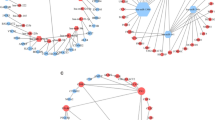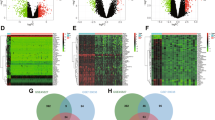Abstract
Epithelial–mesenchymal transition (EMT) is a crucial process that plays an important role in the invasion and metastasis of human cancers. High-mobility group AT-hook 2 (HMGA2) has been found to be involved in the EMT program, with its aberrant expression having been observed in a variety of malignant tumors. However, the mechanisms regulating HMGA2 expression remain incompletely understood. The objective of this study was to investigate whether mir-154 plays a critical role in EMT by regulating HMGA2. The expression levels of HMGA2 were examined in four samples of prostate cancer (PCa) tissue and adjacent non-tumorous tissue by Western blot analysis. The effects of forced expression of miR-154 or HMGA2 knockdown on PCa cells were evaluated by cell migration and invasion assays and Western blot analysis. HMGA2 was upregulated in the PCa tissue samples compared with the adjacent normal ones. Forced expression of miR-154 or HMGA2 knockdown significantly reduced the migratory and invasive capabilities of PCa cells in vitro and inhibited EMT gene expression, increased the levels of E-cadherin, an epithelial marker, and decreased the levels of vimentin, a mesenchymal marker. HMGA2 is a direct target gene of miR-154 by dual-luciferase reporter assay. Our findings suggest that miR-154 plays a role in regulating EMT by targeting HMGA2. Understanding the targets and regulating pathways of miR-154 may provide new insights into the underlying pathogenesis of PCa.





Similar content being viewed by others
References
Yilmaz M, Christofori G (2009) EMT, the cytoskeleton, and cancer cell invasion. Cancer Metastasis Rev 28:15–33
Liu YN, Yin JJ, Abou-Kheir W, Hynes PG, Casey OM, Fang L, Yi M, Stephens RM, Seng V, Sheppard-Tillman H, Martin P, Kelly K (2012) MiR-1 and miR-200 inhibit EMT via Slug-dependent and tumorigenesis via Slug-independent mechanisms. Oncogene 32(3):296–306
Ozcan S (2009) MiR-30 family and EMT in human fetal pancreatic islets. Islets 1:283–285
Bartel DP (2004) MicroRNAs: genomics, biogenesis, mechanism, and function. Cell 116:281–297
Jemal A, Siegel R, Ward E, Hao Y, Xu J, Thun MJ (2009) Cancer statistics, 2009. CA Cancer J Clin 59:225–249
Porkka KP, Pfeiffer MJ, Waltering KK, Vessella RL, Tammela TL, Visakorpi T (2007) MicroRNA expression profiling in prostate cancer. Cancer Res 67:6130–6135
Zhu C, Shao P, Bao M, Li P, Zhou H, Cai H, Cao Q, Tao L, Meng X, Ju X, Qin C, Li J, Yin C (2013) miR-154 inhibits prostate cancer cell proliferation by targeting CCND2. Urol Oncol. doi:10.1016/j.urolonc.2012.11.013
Chiappetta G, Avantaggiato V, Visconti R, Fedele M, Battista S, Trapasso F, Merciai BM, Fidanza V, Giancotti V, Santoro M, Simeone A, Fusco A (1996) High level expression of the HMGI (Y) gene during embryonic development. Oncogene 13:2439–2446
Rogalla P, Drechsler K, Frey G, Hennig Y, Helmke B, Bonk U, Bullerdiek J (1996) HMGI-C expression patterns in human tissues. Implications for the genesis of frequent mesenchymal tumors. Am J Pathol 149:775–779
Gattas GJ, Quade BJ, Nowak RA, Morton CC (1999) HMGIC expression in human adult and fetal tissues and in uterine leiomyomata. Genes Chromosomes Cancer 25:316–322
Farnet CM, Bushman FD (1997) HIV-1 cDNA integration: requirement of HMG I(Y) protein for function of preintegration complexes in vitro. Cell 88:483–492
Wang X, Liu X, Li AY, Chen L, Lai L, Lin HH, Hu S, Yao L, Peng J, Loera S, Xue L, Zhou B, Zhou L, Zheng S, Chu P, Zhang S, Ann DK, Yen Y (2011) Overexpression of HMGA2 promotes metastasis and impacts survival of colorectal cancers. Clin Cancer Res 17:2570–2580
Meyer B, Loeschke S, Schultze A, Weigel T, Sandkamp M, Goldmann T, Vollmer E, Bullerdiek J (2007) HMGA2 overexpression in non-small cell lung cancer. Mol Carcinog 46:503–511
Yang GL, Zhang LH, Bo JJ, Hou KL, Cai X, Chen YY, Li H, Liu DM, Huang YR (2011) Overexpression of HMGA2 in bladder cancer and its association with clinicopathologic features and prognosis HMGA2 as a prognostic marker of bladder cancer. Eur J Surg Oncol 37:265–271
Hetland TE, Holth A, Kaern J, Florenes VA, Trope CG, Davidson B (2012) HMGA2 protein expression in ovarian serous carcinoma effusions, primary tumors, and solid metastases. Virchows Arch 460(5):505–513
Fabjani G, Tong D, Wolf A, Roka S, Leodolter S, Hoecker P, Fischer MB, Jakesz R, Zeillinger R (2005) HMGA2 is associated with invasiveness but not a suitable marker for the detection of circulating tumor cells in breast cancer. Oncol Rep 14:737–741
Winkler S, Escobar HM, Meyer B, Simon D, Eberle N, Baumgartner W, Loeschke S, Nolte I, Bullerdiek J (2007) HMGA2 expression in a canine model of prostate cancer. Cancer Genet Cytogenet 177:98–102
Wu J, Liu Z, Shao C, Gong Y, Hernando E, Lee P, Narita M, Muller W, Liu J, Wei JJ (2011) HMGA2 overexpression-induced ovarian surface epithelial transformation is mediated through regulation of EMT genes. Cancer Res 71:349–359
Thuault S, Tan EJ, Peinado H, Cano A, Heldin CH, Moustakas A (2008) HMGA2 and Smads co-regulate SNAIL1 expression during induction of epithelial-to-mesenchymal transition. J Biol Chem 283:33437–33446
Hebert C, Norris K, Scheper MA, Nikitakis N, Sauk JJ (2007) High mobility group A2 is a target for miRNA-98 in head and neck squamous cell carcinoma. Mol Cancer 6:5
Mayr C, Hemann MT, Bartel DP (2007) Disrupting the pairing between let-7 and Hmga2 enhances oncogenic transformation. Science 315:1576–1579
Lee YS, Dutta A (2007) The tumor suppressor microRNA let-7 represses the HMGA2 oncogene. Genes Dev 21:1025–1030
Kalluri R, Weinberg RA (2009) The basics of epithelial-mesenchymal transition. J Clin Invest 119:1420–1428
Eades G, Yao Y, Yang M, Zhang Y, Chumsri S, Zhou Q (2011) miR-200a regulates SIRT1 expression and epithelial to mesenchymal transition (EMT)-like transformation in mammary epithelial cells. J Biol Chem 286:25992–26002
Malek A, Bakhidze E, Noske A, Sers C, Aigner A, Schafer R, Tchernitsa O (2008) HMGA2 gene is a promising target for ovarian cancer silencing therapy. Int J Cancer 123:348–356
Acknowledgments
This work was supported by the Program for Development of Innovative Research Team in the First Affiliated Hospital of Nanjing Medical University, Provincial Initiative Program for Excellency Disciplines of Jiangsu Province, by the National Natural Science Foundation of China (Grant numbers 81171963, 81102089, and 81201998) and the Natural Science Foundation of Jiangsu Province (Grant number BK2011773).
Conflict of interest
The authors have no financial conflict of interest.
Author information
Authors and Affiliations
Corresponding authors
Additional information
Chen Zhu, Jie Li, and Gong Cheng contributed equally to this work.
Rights and permissions
About this article
Cite this article
Zhu, C., Li, J., Cheng, G. et al. miR-154 inhibits EMT by targeting HMGA2 in prostate cancer cells. Mol Cell Biochem 379, 69–75 (2013). https://doi.org/10.1007/s11010-013-1628-4
Received:
Accepted:
Published:
Issue Date:
DOI: https://doi.org/10.1007/s11010-013-1628-4




